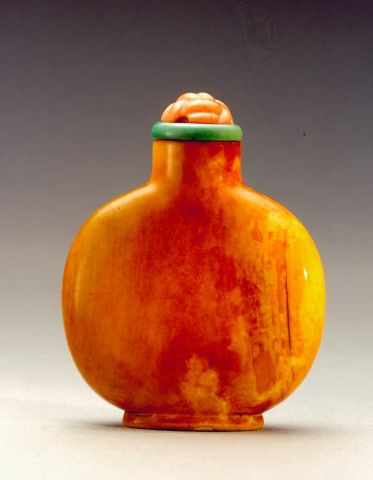
Bottle ID: 289
PLAIN
Date: 1750-1800
Height: 61 mm
Ivory, of rounded flattened form, with a cylindrical neck, and a neatly carved oval footrim, the material very well patinated.
Similar Examples:
Kleiner, Robert. Chinese Snuff Bottles from the Collection of John Ault, 1990, p. 61, no. 105.
Nicollier, Verene. The Baur Collection Geneva, Chinese Snuff Bottles, 2007, pp. 326-327, no. H155.
Low, Denis S.K. More Treasures from the Sanctum of Enlightened Respect, 2002, p. 277, no. 254.
Provenance:
Clare Lawrence Ltd.
The Alexander Brody Collection
Clare Lawrence Ltd.
Sotheby's, Hong Kong, October 30, 1990, lot 226
The Kaynes-Klitz Collection
Published:
Lawrence, Clare. The Alexander Brody Collection of Chinese Snuff Bottles, 1995, p. 47, no. 69
Brody, Alexander. Old Wine into Old Bottles: A Collector's Commonplace Book, 1993, p. 102 and p. 157
One of the joys of snuff bottles to collectors from the 17th century to the present day is the tactile quality that a material such as ivory often affords. Nowhere is this more evident than on this undecorated bottle with its patination revealing the amount of handling it has received over the years. Ivory is a substance that is relatively soft and easy to carve, and the decision to leave the bottle plain is an indication of the quality of the material and the confidence of the carver. It also illustrates the literati’s love of ‘pure form’ objects and their appreciation of natural substances.
The supply of ivory to the Chinese prior to the mid-nineteenth century was from Thailand although it remained a minor item to China’s overseas trade. However, the coming of the steamship dramatically altered China’s trade pattern as did the arrival of European imperialism in Africa, providing a new source of supply for the European traders of these two continents. There is sporadic evidence that around 1760-1790 English traders brought some ivory to Guangzhou, but in such small quantities as to hardly be worth recording. The Chinese records of cargoes (1715-1720) show that it was the Thai and Chinese junks from Thailand, which provided Guangzhou and other areas with its ivory in the early eighteenth century.

 English
English 中文
中文